
a) Tax objectives under COMESA treaty
i) Free movement of goods and services within the region including harmonization of tariffs, internal tariff elimination.
ii) Encouragement of development in the region
iii) A customs union under which goods and services imported from Non-COMESA countries will attract an agreed single tariff in all COMESA states
iv) Same rules of origin of goods apply in the region
b) Rules of origin provision under COMESA
The treaty establishing the COMESA market for eastern and Southern Africa sets out in Article 4(f) the undertaking by member states to effect that they, inter alia, shall: Establish rules of origin with respect to products that shall be eligible for Common Market treatment. The criteria referred to relate to how goods have actually been produced. They are five in number and only one must be complied with for any goods to qualify for COMESA tariff treatment.
i) Goods wholly produced or obtained in a member state (that is, no materials from outside the common market have been used);or
ii) Goods produced in member states whose valued added resulting from the process of production accounts for at least 35% of the ex-factory cost of the goods;
iii) Goods purchased in member states and are classified or become classified under a tariff heading other that the tariff heading under which they were imported; or
iv) Goods of particular importance to the economic development of the member states and containing not less than 25% value added notwithstanding the provision in (a) above.
Wilfykil answered the question on February 25, 2019 at 11:12
-
Kenya has entered into double taxation agreements with a number of countries. Explain the meaning and implications of a double taxation relief.
(Solved)
Kenya has entered into double taxation agreements with a number of countries. Explain the meaning and implications of a double taxation relief.
Date posted:
February 25, 2019
.
Answers (1)
-
Outline the benefits which may accrue to a country from being a signatory to the most favored nation's status agreement
(Solved)
Outline the benefits which may accrue to a country from being a signatory to the most favored nation's status agreement
Date posted:
February 25, 2019
.
Answers (1)
-
Daniel Otwori, a resident of Kenya earned income from the countries listed below during the year ended 31 December 2006. Income from Kenya: ksh 1,765,000
(Solved)
Daniel Otwori, a resident of Kenya earned income from the countries listed below during the year ended 31 December 2006. Income from Kenya: ksh 1,765,000
Income from United Kingdom (UK) UK £4,800 net Tax deducted amounted to UK £960. The average exchange rate during the year was 1 UK £ = 140 KSH, .A double taxation agreement exists between Kenya and United Kingdom.
Required:
The double taxation relief (in Kenya shillings) due to Daniel Otwori for the year ended 31 December 2006.
Date posted:
February 25, 2019
.
Answers (1)
-
Hodari Nkan is resident of Kenya. During the year ended 31 December 2010, he received the following income:
(Solved)
Hodari Nkan is resident of Kenya. During the year ended 31 December 2010, he received the following income:
From Kenya: Sh. 720,000
From Zambia Sh. 540,000 (net of tax of sh. 78,000)
Assume that Kenya has a double taxation agreement with Zambia
Required:
The double taxation relief due to Hodari Nkan for the year ended 31 December 2010
Date posted:
February 25, 2019
.
Answers (1)
-
Identify and explain instances when a capital statement may be required.
(Solved)
Identify and explain instances when a capital statement may be required.
Date posted:
February 25, 2019
.
Answers (1)
-
Outline the main types of duties to be levied on goods according to the provisions of the Customs and Excise Act (Cap.472).
(Solved)
Outline the main types of duties to be levied on goods according to the provisions of the Customs and Excise Act (Cap.472).
Date posted:
February 25, 2019
.
Answers (1)
-
Giving appropriate examples, distinguish between forward and backward tax shifting.
(Solved)
Giving appropriate examples, distinguish between forward and backward tax shifting.
Date posted:
February 25, 2019
.
Answers (1)
-
Define the term "shortfall distribution tax". Under what circumstances can a company be exempted from shortfall distribution tax?
(Solved)
Define the term "shortfall distribution tax". Under what circumstances can a company be exempted from shortfall distribution tax?
Date posted:
February 25, 2019
.
Answers (1)
-
Write brief notes on the bodies the tax payer may appeal to incase he/she is aggrieved by the manner in which an objection for tax...
(Solved)
Write brief notes on the bodies the tax payer may appeal to incase he/she is aggrieved by the manner in which an objection for tax assessment to the commissioner has been dealt with.
Date posted:
February 25, 2019
.
Answers (1)
-
Write brief notes on Objections by the taxpayer of an assessment done by the commissioner
(Solved)
Write brief notes on Objections by the taxpayer of an assessment done by the commissioner
Date posted:
February 25, 2019
.
Answers (1)
-
Explain five types of notices of assessment
(Solved)
Explain five types of notices of assessment
Date posted:
February 25, 2019
.
Answers (1)
-
What are the contents of a notice of assessment?
(Solved)
What are the contents of a notice of assessment?
Date posted:
February 25, 2019
.
Answers (1)
-
Write brief notes on back duty.
(Solved)
Write brief notes on back duty.
Date posted:
February 25, 2019
.
Answers (1)
-
Explain the meaning of tax evasion
(Solved)
Explain the meaning of tax evasion
Date posted:
February 25, 2019
.
Answers (1)
-
It may be advantageous for a trader whose turnover is below the legislated turnover limits under the sixth schedule to the V AT Act to...
(Solved)
It may be advantageous for a trader whose turnover is below the legislated turnover limits under the sixth schedule to the V AT Act to register for VAT voluntarily. Under what circumstances could this be beneficial?
Date posted:
February 25, 2019
.
Answers (1)
-
Mrs. Carol Wasike is a practicing accountant working under the style and name of Wasike and Associates. Her firm is registered for Value Added Tax...
(Solved)
Mrs. Carol Wasike is a practicing accountant working under the style and name of Wasike and Associates. Her firm is registered for Value Added Tax (VAT). During the month of September 2001, she undertook and completed the following assignments:
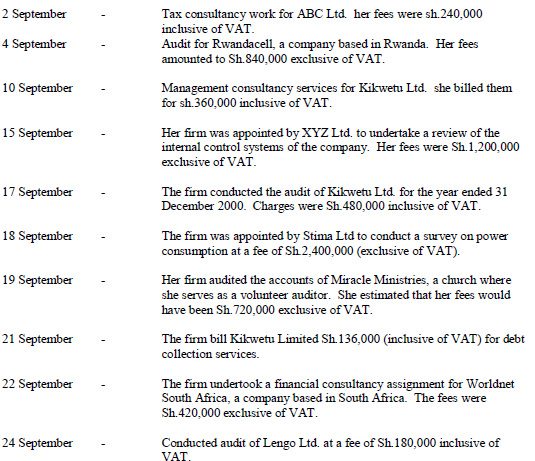
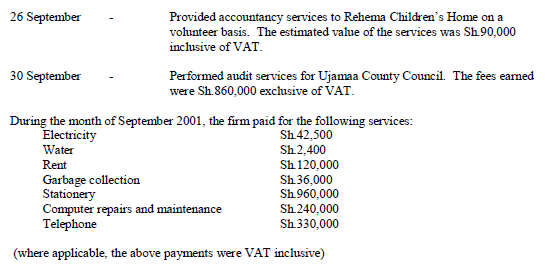
Required:
(a) Prepare a VAT Account for Wasike and Associates for the month of September 2001.
(b) The VAT you have computed in (a) above, was paid on 22 October 2001 since 20 October was on a Saturday. The VAT return was also submitted on the same day. How much additional tax would be payable, if any?
(c) Kikwetu Limited was the subject of a creditors voluntary winding up and the appropriate resolution was passed on 1 April 2002. By that time the company paid Wasike and Associates only Sh.240,000 for services rendered. Assuming that all the conditions for the refund of bad debt relief are met, calculate the amount of VAT bad debt relief.
Date posted:
February 25, 2019
.
Answers (1)
-
Mr. Joseph Omuora commenced a soft drinks distribution business on 1 January 1998. He has not been maintaining proper books of account and the Commissioner...
(Solved)
Mr. Joseph Omuora commenced a soft drinks distribution business on 1 January 1998. He has not been maintaining proper books of account and the Commissioner of Income Tax has raised doubts about the accuracy of the annual tax returns submitted by him.
You have been appointed to estimate the correct amounts of taxable incomes for the years ended 31 December 1998, 1999, 2000, 2001 for comparison with those disclosed in the annual returns. These returns had disclosed the following profits or losses:
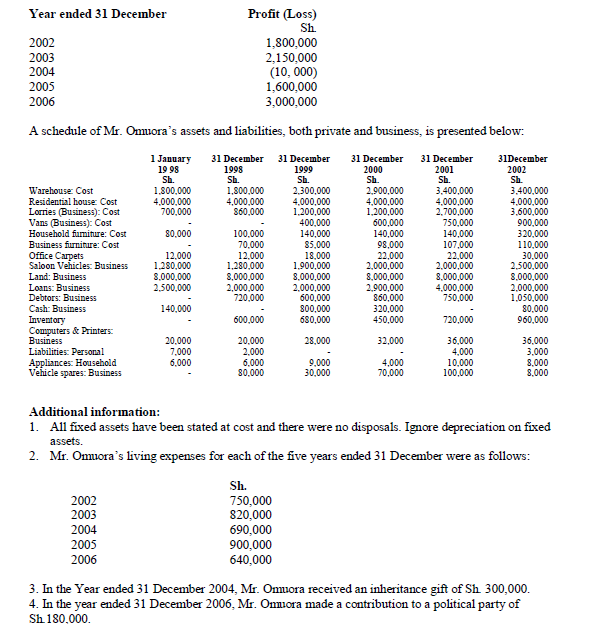
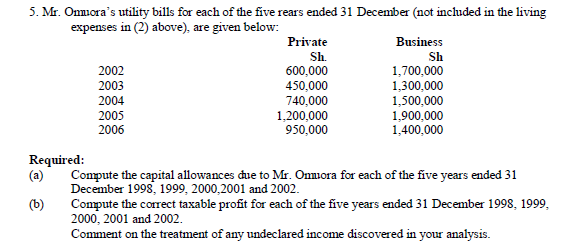
Date posted:
February 25, 2019
.
Answers (1)
-
Mediner Ltd. deals in a variety of goods in the month of September 2004, the Company accountant recorded the following transactions (exclusive of VAT):
(Solved)
Mediner Ltd. deals in a variety of goods in the month of September 2004, the Company accountant recorded the following transactions (exclusive of VAT):
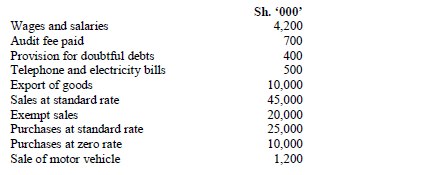
The accountant believes that the allocative method is the best in restricting the input VAT deductible against output VAT. The accountant is also of the opinion that on average, twenty percent of the standard rate purchases were sold as standard rate sales.
Required:
Compute the input VAT deductible against output VAT using the allocative method.
Date posted:
February 25, 2019
.
Answers (1)
-
Explain how section 19 (1) of the VAT Act, on recovery of “tax due and payable from a person who owes money to the tax...
(Solved)
Explain how section 19 (1) of the VAT Act, on recovery of “tax due and payable from a person who owes money to the tax payer” may be enforced by the commissioner.
Date posted:
February 25, 2019
.
Answers (1)
-
Explain the requirements of an application for refund of VAT paid in respect of Bad debts.
(Solved)
Explain the requirements of an application for refund of VAT paid in respect of Bad debts.
Date posted:
February 25, 2019
.
Answers (1)